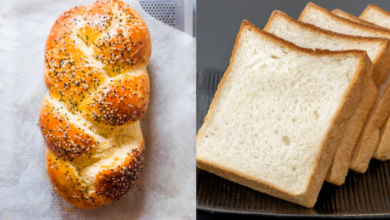Why Is My Challah Bread So Dense? Here’s The Answer You Didn’t Expect!
What To Know
- Excessive kneading can develop the gluten in the dough too much, resulting in a tough and dense texture.
- Allow the dough to proof in a warm, draft-free place for at least 1 hour, or until doubled in size.
- With a little patience and attention to detail, you can overcome the challenges of dense challah bread and create light and airy loaves that will impress your family and friends.
Aspiring bakers often encounter the frustration of dense and heavy challah bread. This can be a disheartening experience, especially when you’ve put in the effort to create a fluffy and airy masterpiece. Understanding the reasons behind dense challah can help you troubleshoot and achieve the perfect loaf every time.
Common Causes of Dense Challah
1. Overworking the Dough
Excessive kneading can develop the gluten in the dough too much, resulting in a tough and dense texture. Gluten strands become overly elastic, restricting the bread’s ability to rise and create air pockets.
2. Insufficient Proofing
Proofing is a crucial step that allows yeast to ferment and produce carbon dioxide gas. This gas creates air pockets that give challah its characteristic lightness. If the dough is not proofed for long enough, the yeast will not have sufficient time to generate enough gas, leading to a dense loaf.
3. Incorrect Liquid Ratio
The liquid content in challah dough plays a significant role in its texture. Too little liquid can result in a dry and crumbly loaf, while too much can make the dough sticky and dense. The ideal dough consistency should be slightly sticky but not overly wet.
4. Improper Mixing
Thorough mixing ensures that all ingredients are evenly distributed throughout the dough. If the ingredients are not mixed properly, dry pockets can form, resulting in an uneven and dense texture.
5. Overcrowding the Pan
When the challah dough is placed in the baking pan, it needs space to rise and expand. Overcrowding the pan can prevent the bread from rising properly, leading to a dense and compact loaf.
6. Incorrect Baking Temperature
The oven temperature is crucial for achieving the perfect challah. If the temperature is too low, the bread will not rise sufficiently, resulting in a dense texture. If the temperature is too high, the crust will brown too quickly, preventing the bread from cooking through.
7. Overbaking
Baking challah for too long can dry out the bread and make it dense. It’s important to bake the bread until it reaches an internal temperature of 190-200°F (88-93°C) to ensure it is cooked through without overbaking.
Troubleshooting Tips
1. Knead Gently and Briefly
Knead the dough just until it comes together and forms a ball. Avoid overworking it.
2. Proof Patiently
Allow the dough to proof in a warm, draft-free place for at least 1 hour, or until doubled in size.
3. Adjust Liquid Gradually
Start with the minimum amount of liquid required in the recipe and gradually add more until the dough reaches the desired consistency.
4. Mix Thoroughly
Use a stand mixer or a wooden spoon to ensure all ingredients are evenly incorporated.
5. Space Out Your Challah
Place the challah in a baking pan with enough space for it to expand.
6. Calibrate Your Oven
Use an oven thermometer to ensure the oven temperature is accurate.
7. Monitor Baking Time
Insert a toothpick into the center of the challah. If it comes out clean, the bread is done.
In a nutshell: Crafting Perfect Challah
With a little patience and attention to detail, you can overcome the challenges of dense challah bread and create light and airy loaves that will impress your family and friends. Remember to troubleshoot common issues, follow these tips, and experiment with different techniques until you find what works best for you.
Answers to Your Questions
Why does my challah bread have a gummy texture?
A gummy texture can be caused by overproofing the dough or using too much liquid. Ensure you proof the dough for the correct amount of time and adjust the liquid content as needed.
How can I make my challah bread more flavorful?
Enhance the flavor of your challah by adding spices such as cinnamon, nutmeg, or cardamom. You can also incorporate herbs like thyme or rosemary.
What is the secret to a golden-brown challah crust?
Brush the challah with an egg wash before baking. This will create a shiny and golden crust. You can also sprinkle sesame seeds or poppy seeds on top for extra flavor and texture.
